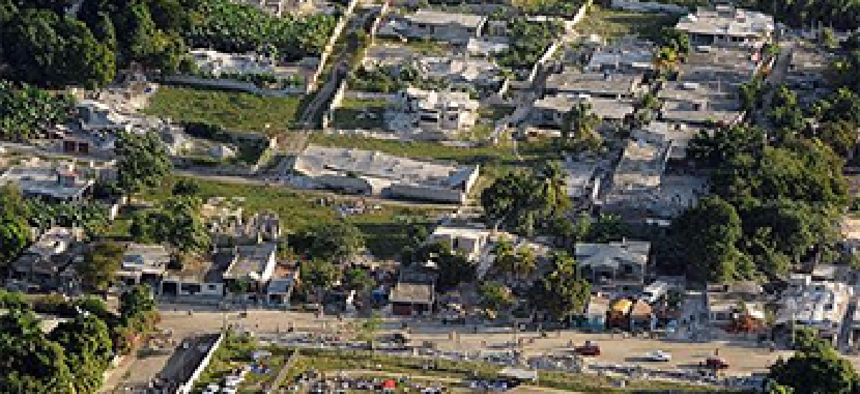The future of government mobility

In a 'brave new world,' government adapts on the fly to innovation.

After an earthquake struck Haiti in 2010, text messages and social media aided the rescue efforts. (Coast Guard photo by Petty Officer 2nd Class Sondra-Kay Kneen)
The concept of mobility in the government today is a source of many things: excitement, productivity, innovation, consternation. The vision for tomorrow, however, is a much broader, wide-open horizon of potential uses and applications.
These days, mobility conversations center on what usage should and will look like just as much as they center on establishment and implementation of policies. In other areas, such an approach would be putting the proverbial cart before the horse, but mobility demands it.
Those demands come in the form of soldiers needing better communications on the battlefield, agencies looking for savings that mobility can help yield, disaster response that hinges on quickness and agility, and a citizenry that insists the government catch up with commercial IT.
"It is a brave new world. There are a lot of capabilities," Rear Adm. Ron Hewitt, director of the office of emergency communications at the Homeland Security Department, said Aug. 8 at the AFCEA Bethesda Mobile Technology Symposium in Washington. "There's a lot of innovation that's occurring, and we're all adapting on the fly."
Expect to see the government collaborating in new and different ways to meet the pressing demands, including agencies working together as well as with non-governmental organizations, according to Thom Rubel, vice president of IDC Government Insights.
"Government organizations are going to partner with other agencies to create wholeness around [the rapidly increasing use of] applications. Citizens don't care who it comes from – what they really want is something useful in the end," Rubel said. He also noted that people are abandoning personal computers in record numbers. "In 2015 we're projecting there will be more consumers in the U.S. accessing the Internet through mobile devices than through PCs."
At the Defense Department, mobile technologies already play a critical role that will continue to grow as leaders at the top and troops on the ground push for more mobility – and as the services hash out responsibilities and authorities. Already, some70 mobile pilot programs have helped meet and prove military requirements, and officials must determine how to move forward.
"It's been a juggling act," admitted Brian Teeple, principle director for the deputy CIO for command, control, communications and computers and information infrastructure capabilities in the DOD CIO office. Nonetheless, expect the Pentagon in the coming years to have a list of approved mobile devices, mobile device management policies in place, a DOD app store, shared services and a reduction in desktops, laptops, offices and landlines, he said.
But the Pentagon won't be completely virtual just yet, he added.
"I think there will still be some challenges – how do we incorporate satellite communications so that there's no out-of-range for the soldier? Some of the security measures will still be evolving – face recognition, voice recognition, and how do you use that instead of a [common access card] with a sled hooked up to a device?" Teeple said. "Those things are all in the works. We've seen them. They've been kind of lower priority to make sure we're doing this securely, but...we'll be trying to decide what the right way is and how to implement."
In the world of disaster response, mobile devices have proven critical for some time, and officials are anxious to further institute tools for taking action when a catastrophe strikes.
In 2010, the earthquake that struck Haiti revealed the importance of mobility: survivors sent text messages beneath the rubble, and social networks were central to getting a handle on the damage and aftermath. After 2011's massive earthquake in Japan, social media again proved to be a lifeline. And when the Japanese government was slow to release data related to damaged nuclear reactors, citizen scientists put together their own plans for monitoring and mapping the situation, forcing the government into greater transparency, according to Jody Ranck, author of "Connected Health: How Mobile Phones, Cloud and Big Data will Reinvent Healthcare."
Today, the U.S. government is building on such examples. The Federal Emergency Management Agency and the National Telecommunications and Information Administration are spearheading efforts that will shape the future of mobility in crisis response.
"The future I think my program is heading [toward] is becoming a data provider; not for my federal partners, but for the disaster [response] community, all the way down to state and local levels," said Karole Johns, program manager at FEMA's disaster assistance improvement program. "Eventually we will become an intake service. We will collect all of the information from a disaster or survivor event, package it and pass it back to whatever entity is authorized to receive that data."
At the NTIA, the First Responder Network Authority (FirstNet) is set to become the first nationwide, high-speed network dedicated to public safety, with 56 states and territories assigned a coordinator and planning to roll out dedicated broadband services, Hewitt said.
"FirstNet will move public safety to the next generation," Hewitt said. "No network now in the United States provides national coverage, and yet this has been identified to provide that national coverage."
While the program is "still in its infancy," it involves an estimated 35,000 radio access networks and a nationwide spectrum license to link first responders at all levels. Work now under way to set up the network includes outreach and agreements with states and tribal governments.
NEXT STORY: How to measure training effectiveness





